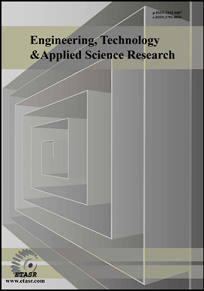Estimation οf Wave Overtopping Discharges at Coastal Structures with Combined Slopes using Machine Learning Techniques
Received: 1 March 2024 | Revised: 17 March 2024 | Accepted: 19 March 2024 | Online: 1 June 2024
Corresponding author: Moussa S. Elbisy
Abstract
Coastal defense structures are of paramount importance in protecting coastal communities from the adverse impacts of severe weather events and flooding. This study uses machine learning techniques, specifically Decision Tree (DT), Gradient Boosted Tree (GBT), and Support Vector Machine (SVM) models, to estimate wave overtopping discharge at coastal structures with combined slopes employing the recently built EurOtop database. The models were evaluated by deploying statistical metrics and Taylor diagram visualization. The GBT model demonstrated a high level of accuracy in predicting wave-overtopping discharge. Compared to the other models, the scatter index of GBT (0.392) was lower than that of DT (0.512) and SVM (0.823). In terms of the R-index, GBT (0.991) was superior to DT (0.977) and SVM (0.943). The GBT results were also compared with those of previous works. The findings showed that the GBT model significantly decreased the overall error and provided accurate estimations of the wave-overtopping discharge.
Keywords:
coastal defense, wave overtopping, prediction, gradient boosted trees, decision trees, support vector machines, safetyDownloads
References
S. Dong, S. Abolfathi, M. Salauddin, Z. H. Tan, and J. M. Pearson, "Enhancing climate resilience of vertical seawall with retrofitting - A physical modelling study," Applied Ocean Research, vol. 103, Oct. 2020, Art. no. 102331.
M. Salauddin, J. J. O’Sullivan, S. Abolfathi, Z. Peng, S. Dong, and J. M. Pearson, "New insights in the probability distributions of wave-by-wave overtopping volumes at vertical breakwaters," Scientific Reports, vol. 12, no. 1, Sep. 2022, Art. no. 16228.
M. B. Mehrabani, H.-P. Chen, and M. W. Stevenson, "Overtopping failure analysis of coastal flood defences affected by climate change," Journal of Physics: Conference Series, vol. 628, no. 1, Mar. 2015, Art. no. 012049.
J. W. van der Meer, H. Verhaeghe, and G. J. Steendam, "The new wave overtopping database for coastal structures," Coastal Engineering, vol. 56, no. 2, pp. 108–120, Feb. 2009.
T. Pullen, N. W. H. Allsop, T. Bruce, A. Kortenhaus, H. Schüttrumpf, and J. W. van der Meer, "EurOtop wave overtopping of sea defences and related structures: assessment manual," Die Küste, 2007.
S. M. Formentin, B. Zanuttigh, and J. W. van der Meer, "A Neural Network Tool for Predicting Wave Reflection, Overtopping and Transmission," Coastal Engineering Journal, vol. 59, no. 1, Mar. 2017.
B. Zanuttigh, S. M. Formentin, and J. W. van der Meer, "Prediction of extreme and tolerable wave overtopping discharges through an advanced neural network," Ocean Engineering, vol. 127, pp. 7–22, Nov. 2016.
J. P. den Bieman, J. M. Wilms, H. F. P. van den Boogaard, and M. R. A. van Gent, "Prediction of Mean Wave Overtopping Discharge Using Gradient Boosting Decision Trees," Water, vol. 12, no. 6, Jun. 2020, Art. no. 1703.
J. P. den Bieman, M. R. A. van Gent, and H. F. P. van den Boogaard, "Wave overtopping predictions using an advanced machine learning technique," Coastal Engineering, vol. 166, Jun. 2021, Art. no. 103830.
M. S. Elbisy, F. A. Osra, and Y. S. Alyafei, "Soft computing techniques for predicting wave overtopping discharges at vertical coastal structures," GEOMATE Journal, vol. 23, no. 98, pp. 205–211, Oct. 2022.
A. H. Alshahri and M. S. Elbisy, "Prediction of Wave Overtopping Discharges at Coastal Structures Using Artificial Neural Networks and Support Vector Machine Tecniques," GEOMATE Journal, vol. 23, no. 99, pp. 56–62, Nov. 2022.
Y. T. Tsai and C. P. Tsai, "Predictions of Wave Overtopping Using Deep Learning Neural Networks," Journal of Marine Science and Engineering, vol. 11, no. 10, Oct. 2023, Art. no. 1925.
M. S. Elbisy, "Machine learning techniques for estimating wave-overtopping discharges at coastal structures," Ocean Engineering, vol. 273, Apr. 2023, Art. no. 113972.
IBM Cloud Education, "IBM Cloud Learn Hub," Machine Learning. July, 2020.
K. Theofilatos, S. Likothanassis, and A. Karathanasopoulos, "Modeling and Trading the EUR/USD Exchange Rate Using Machine Learning Techniques," Engineering, Technology & Applied Science Research, vol. 2, no. 5, pp. 269–272, Oct. 2012.
D. Dhall, R. Kaur, and M. Juneja, "Machine Learning: A Review of the Algorithms and Its Applications," in Proceedings of ICRIC 2019, 2020, pp. 47–63.
V. Vapnik, S. Golowich, and A. Smola, "Support Vector Method for Function Approximation, Regression Estimation and Signal Processing," in Advances in Neural Information Processing Systems, 1996, vol. 9.
S. B. Kotsiantis, I. D. Zaharakis, and P. E. Pintelas, "Machine learning: a review of classification and combining techniques," Artificial Intelligence Review, vol. 26, no. 3, pp. 159–190, Nov. 2006.
T. Sharma, P. Gupta, V. Nigam, and M. Goel, "Customer Churn Prediction in Telecommunications Using Gradient Boosted Trees," in International Conference on Innovative Computing and Communications, 2020, pp. 235–246.
M. R. A. van Gent, H. F. P. van den Boogaard, B. Pozueta, and J. R. Medina, "Neural network modelling of wave overtopping at coastal structures," Coastal Engineering, vol. 54, no. 8, pp. 586–593, Aug. 2007.
Downloads
How to Cite
License
Copyright (c) 2024 Moussa S. Elbisy

This work is licensed under a Creative Commons Attribution 4.0 International License.
Authors who publish with this journal agree to the following terms:
- Authors retain the copyright and grant the journal the right of first publication with the work simultaneously licensed under a Creative Commons Attribution License that allows others to share the work with an acknowledgement of the work's authorship and initial publication in this journal.
- Authors are able to enter into separate, additional contractual arrangements for the non-exclusive distribution of the journal's published version of the work (e.g., post it to an institutional repository or publish it in a book), with an acknowledgement of its initial publication in this journal.
- Authors are permitted and encouraged to post their work online (e.g., in institutional repositories or on their website) after its publication in ETASR with an acknowledgement of its initial publication in this journal.






